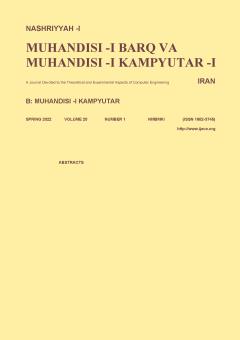ارائه یک مدل آگاه از انرژی و مبتنی بر زنجیره مارکوف به منظور مدیریت پویای ماشینهای مجازی در مراکز داده ابری
الموضوعات : electrical and computer engineeringمهدی رجب زاده 1 , ابوالفضل طرقی حقیقت 2 , امیرمسعود رحمانی 3
1 - دانشگاه آزاد اسلامی واحد علوم و تحقیقات،گروه مهندسی كامپيوتر
2 - دانشگاه آزاد اسلامی واحد قزوین،دانشکده مهندسی کامپیوتر
3 - دانشگاه آزاد اسلامی واحد علوم و تحقیقات،گروه مهندسی كامپيوتر
الکلمات المفتاحية: الگوریتمهای فرااکتشافی, رایانش ابری, زنجیره مارکوف جاذب, کاهش مصرف انرژی,
ملخص المقالة :
استفاده از راهکارهای آگاه از انرژی از موضوعات مهم تحقیقاتی در حوزه رایانش ابری است. با کاربرد مؤثر الگوریتمهای جایگذاری و تجمیع ماشینهای مجازی، تأمینکنندگان ابر قادر خواهند بود مصرف انرژی را کاهش دهند. در این مقاله مدل جدیدی ارائه شده که با بهبود در الگوریتمها و ارائه روشهای مناسب، به دنبال رسیدن به نتایج مطلوب است. نظارت دورهای بر وضعیت منابع، تحلیل مناسب دادههای به دست آمده و پیشبینی وضعیت بحرانی سرورها به کمک مدل مارکوف پیشنهادی سبب شده است که تا حد امکان از تعداد مهاجرتهای غیر ضروری کاسته شود. ترکیب الگوریتمهای ژنتیک و شبیهسازی تبرید در بخش جایگزینی در کنار تعریف زنجیره مارکوف جاذب باعث عملکرد بهتر و سریعتر الگوریتم پیشنهادی گردیده است. شبیهسازیهای انجامشده در سناریوهای مختلف در کلودسیم نشان میدهد که در مقایسه با بهترین الگوریتم مورد مقایسه قرار گرفته، در بار کم، متوسط و زیاد، مصرف انرژی کاهش قابل توجهی داشته و این در حالی است که نقض توافقات سطح سرویسدهی نیز به طور متوسط 17 درصد کاهش یافته است.
[1] A. Beloglazov and R. Buyya, Energy-Efficient Management of Virtual Machines in Data Centers for Cloud Computing, Ph.D Thesis, Melbourne University, May 2013.
[2] A. Y. Zomaya and Y. C. Lee, Energy Efficient Distributed Computing Systems, Wiley-IEEE Computer Society Press, Jul. 2016.
[3] A. Khosravi, S. G. Kumar, and R. Buyya, "Energy and carbon-efficient placement of virtual machines in distributed cloud data centers," in Proc. of the 19th In. Conf. on Parallel Processing Euro-Par'13, pp. 317-328, Aachen, Germany, 26-30 Aug. 2013.
[4] J. Yang, C. Liu, and Y. Shang, "A cost-aware auto-scaling approach using the workload prediction in service clouds," Inf Syst Front, vol. 16, pp. 7-18, Oct. 2017.
[5] R. Nathuji, C. Isci, and E. Gorbatov, "Exploiting platform heterogeneity for power efficient data centers," in Proc. of the 4th Int. Conf. on Autonomic Computing, vol. 7, pp. 5-15, May 2017.
[6] E. Feller, et al., "Energy management in IaaS clouds: a holistic approach," in Proc. IEEE 5th Inte. Conf. on, Cloud Computing, pp. 204-212, Honolulu, HI, USA, 24-29 Jun. 2018.
[7] A. Beloglazov and R. Buyya, "Managing overloaded PMs for dynamic consolidation of virtual machines in cloud data centers under quality of service constraints," IEEE Trans. Parallel Distrib Syst, vol. 24, no. 7, pp. 1366-1379, Sep. 2013.
[8] G. Katsaros, et al., "A service framework for energy-aware monitoring and VM management in clouds," Future Generation Computer Systems, vol. 29, no. 8, pp. 2077-2091, Jan. 2015.
[9] I. Takouna, R. Rojas-Cessa, K. Sachs, and C. Meinel, "Communication-aware and energy-efficient scheduling for parallel applications in virtualized data centers," in Proc. 6th IEEE/ACM Int. Conf. on Utility and Cloud Computing, UCC’13, pp. 251-255, Dresden, Germany, 9-12 Dec. 2013.
[10] L. Salimian, F. S. Esfahani, and M. N. Shahraki, "An adaptive fuzzy threshold-based approach for energy and performance efficient consolidation of virtual machines," Computing, vol. 98, no. 6, pp. 641-660, Mar. 2016.
[11] K. G. Saurabh, S. Y. Chee, and R. Buyya, "Green cloud framework for improving carbon efficiency of clouds," in Proc. of the 17th Int. European Conf. on Parallel and Distributed Computing, EuroPar’11, vol. 6853, pp. 193-203, LNCS, Springer, Germany, Dec. 2011.
[12] T. Mahdhi and H. Mezni, "A prediction-based VM consolidation approach in IaaS cloud data centers," The J. of Systems & Software, vol. 146, no. 12, pp. 263-285, Sept. 2018.
[13] I. Mohiuddin and A. Almogren, "Workload aware VM consolidation method in edge/cloud computing for IoT applications," J. Parallel Distrib. Comput., vol. 123, no. 1, pp. 204-214, Sept. 2019.
[14] M. Malekloo, N. Kara, and M. Barachi, "An energy efficient and SLA compliant approach for resource allocation and consolidation in cloud computing environments," Sustainable Computing. Informatics and Systems, vol. 17, no. 2, pp. 9-24, Feb. 2019.
[15] H. Xu, Y. Liu, W. Wei, and Y. Xue, "Migration cost and energy-aware virtual machine consolidation under cloud environments considering remaining runtime," International J. of Parallel Programming, vol. 47, no. 1, pp. 481-501 , Mar. 2020.
[16] Z. Luo and Z. Qian, "Burstiness-aware server consolidation via queuing theory approach in a computing cloud," in Proc. IEEE 27th Int. Symp. on Parallel Distributed Processing, IPDPS’16, pp. 332-341, Cambridge, MA, USA, 20-24 May 2016.
[17] S. B. Melhem, A. Agrawal, N. Goel, and M. Zaman, "Markov prediction model for host load detection and VM placement in live migration, " IEEE Access, vol. 6, pp. 7190-7205, 2020.
[18] A. Vasan and K. S. Raju, "Comparative analysis of simulated annealing, simulated quenching and genetic, algorithms for optimal reservoir operation," Appl Soft Comput., vol. 9, no. 1, pp. 274-281, May 2016.
[19] C. Oysu and Z. Bingul, "Application of heuristic and hybrid-GASA algorithms to tool-pathoptimization problem for minimizing airtime during machining," Engineering Applications of Artificial Intelligence, vol. 22, no. 3, pp. 389-396, Apr. 2017.
[20] M. Rajabzadeh, A. T. Haghighat, and A. M. Rahmani, "New comprehensive model based on virtual clusters and absorbing Markov chains for energy-efficient virtual machine management in cloud computing," J. Supercomput., vol. 76, no. 9, pp. 7438-7457, Dec. 2020.
[21] A. Aryania, H. S. Aghdasi, and L. Mohammad Khanli, "Energy-aware virtual machine consolidation algorithm based on ant colony system," J. Grid Computing, vol. 16, no. 2, pp. 477-491, Jul. 2019.
[22] N. Chaurasia, M. Kumar, and R. Chaudhry, "Comprehensive survey on energy-aware server consolidation techniques in cloud computing," J. Supercomput., vol. 77, no. 10, pp. 11682-11737, May 2021.
[23] M. Ala'anzy and M. Othman, "Mapping and consolidation of VMs using locust-inspired algorithms for green cloud computing," Neural Process Lett., vol. 77, no. 10, Oct. 2021.


